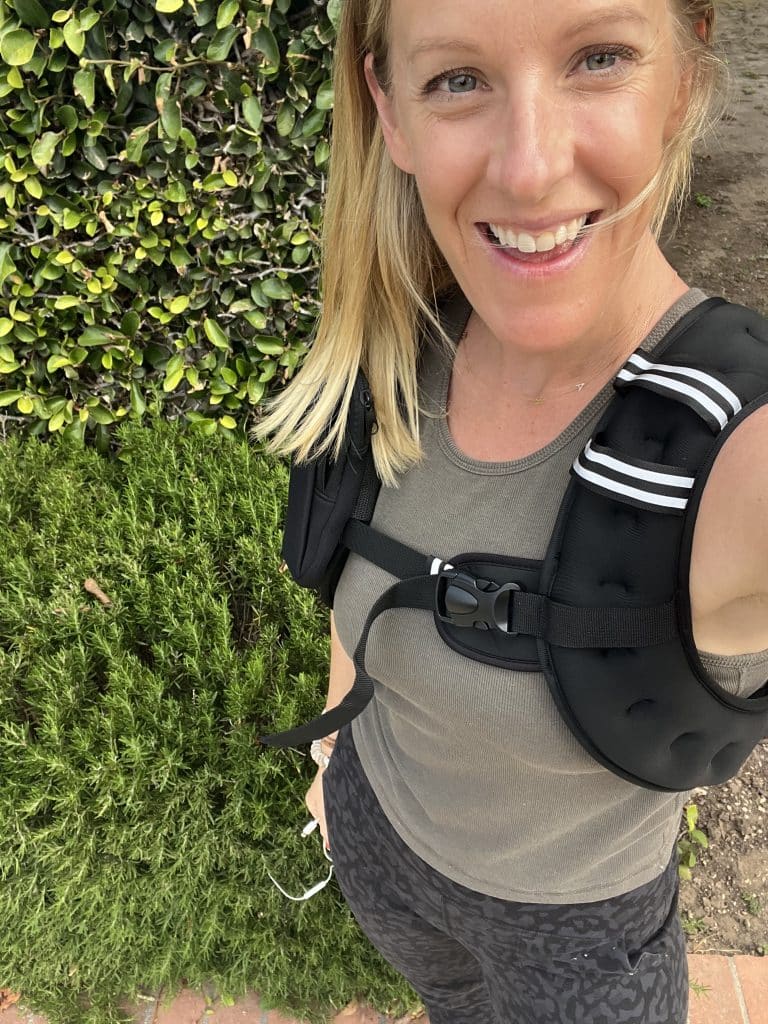
If you’ve been hearing the buzz about weighted vests lately, you’re not alone. Maybe a friend mentioned it during your walk, or you spotted one in a social post and thought, Wait, should I be doing that too?
If you know me, you know that I’m always a little skeptical of anything that becomes quickly trendy – or anything that people claim as the “secret” to success.
But at the same time, I’m interested in ALL things health and wellness and like many of you, want to do all that I can to maintain bone health and build strength, so I dove into the research for myself and to provide a guide for you if you’re interested in adding a weighted vest to your walking routine.
Let’s walk through it together.
Why Weighted Vests Are Trending
As we age, especially during and after menopause, bone density typically declines. This can increase the risk of osteoporosis and fractures. The good news? Weight-bearing exercise is one of the most effective ways to support bone health and that’s where the weighted vest comes in.
Unlike high-impact workouts, wearing a weighted vest adds gentle resistance to movements you’re already doing like walking or even doing chores around the house. It’s like giving your bones a little extra challenge without the strain of lifting heavy weights.
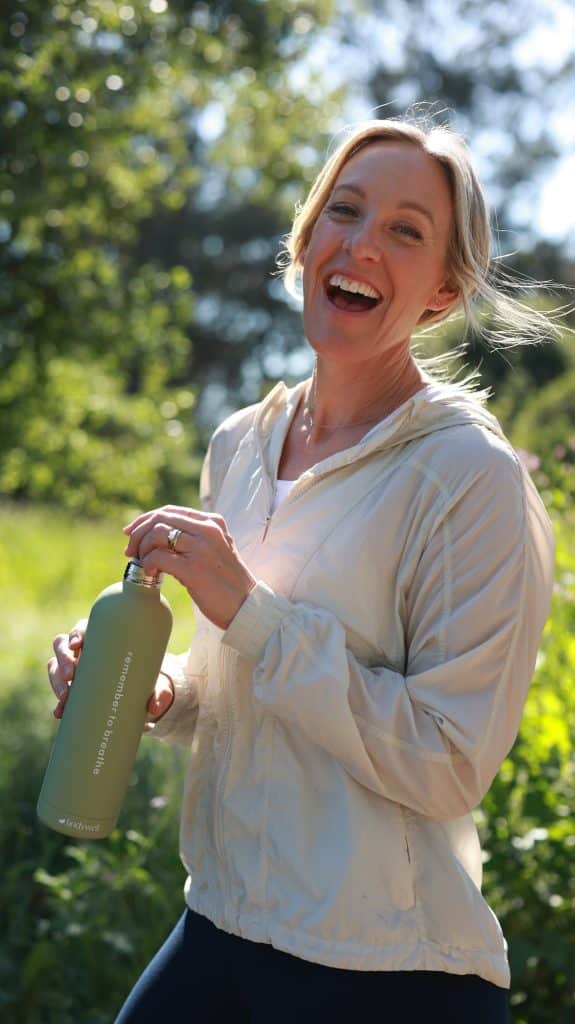
The Science Behind the Support
One interesting study set out to find out if wearing a weighted vest while doing exercises help older women get stronger, improve balance, and avoid falling and breaking bones.
What they did:
They asked a group of women (ages 50–75) to do special leg-strengthening exercises while wearing a weighted vest, three times a week, for 9 months. Another group didn’t change anything – they just kept doing what they normally did.
What they found:
The women who exercised with the vest got stronger, had better balance, and built a little more muscle in their legs. But their bones didn’t get any denser during the study.
What it means:
Wearing a weighted vest during exercise can help older women stay steadier and stronger, which may lower the chance of falling. That’s important, because better balance and strength can help protect them from breaking bones, even if their bones don’t get thicker right away.
Another study showed similar results:
What they did:
They asked a group of women in their 60s to do jumping exercises while wearing a weighted vest, three times a week, for 5 years. Another group didn’t do the program but stayed active in their usual ways. They checked their hip bone strength at the beginning and end.
What they found:
The women who did the jumping and wore the vest mostly kept their hip bones strong. The women who didn’t do the program lost a lot more bone strength over the 5 years.
What it means:
Doing regular jumping exercises with a weighted vest can help older women keep their hips strong as they age. But it also begs the question, could women have had similar results simply jumping (which is a bone-strengthening exercise) even without the weighted vest?
Another example is a study that tested whether wearing a weighted vest while doing different types of exercises help older women get stronger and improve their bone health.
What they did:
They had a group of postmenopausal women do exercises three times a week for 12 weeks while wearing a vest that got heavier over time (up to 15% of their body weight). Another group didn’t do the exercises. They looked at changes in bone health, strength, and body fat.
What they found:
The women who exercised had better bone health markers, especially a big drop in a sign that bones are breaking down. They also got much stronger in their ankles and lost body fat while gaining muscle.
What it means:
Wearing a weighted vest during exercise can help older women get stronger, protect their bones, and improve body composition. But again, it’s unclear how much the weighted vest supported those exercises vs. doing the exercises alone.
What you’ll notice, is that I was not able to find a study that specifically studied the effects of WALKING with a weighted vest and impact on bone density in women.
(If you know of one, please send it my way, I’d love to see it!)
We do know for sure that consistent, low-impact weight-bearing exercise (like walking) can help improve or maintain bone density. But results are fairly inconclusive as to whether or not walking with a weight vest brings significant improvement in bone health compared to walking alone.
Weighted vests have been shown to increase physiological stress on the body and therefore increase exertion levels while exercising, which can have cardiovascular and calorie burn benefits.
Which makes sense. When you add weight to your body while walking your body will have to exert more energy to move that amount of weight, therefore increasing calorie burn and exertion. So we can assume there is a caloric and strength benefit there, we just don’t know how dramatically it would impact your results.
The key takeaway? The jury is out on if adding a weighted vest to your workout is going to radically transform your bone health, but it may help to up the intensity of your walks and burn a few extra calories.
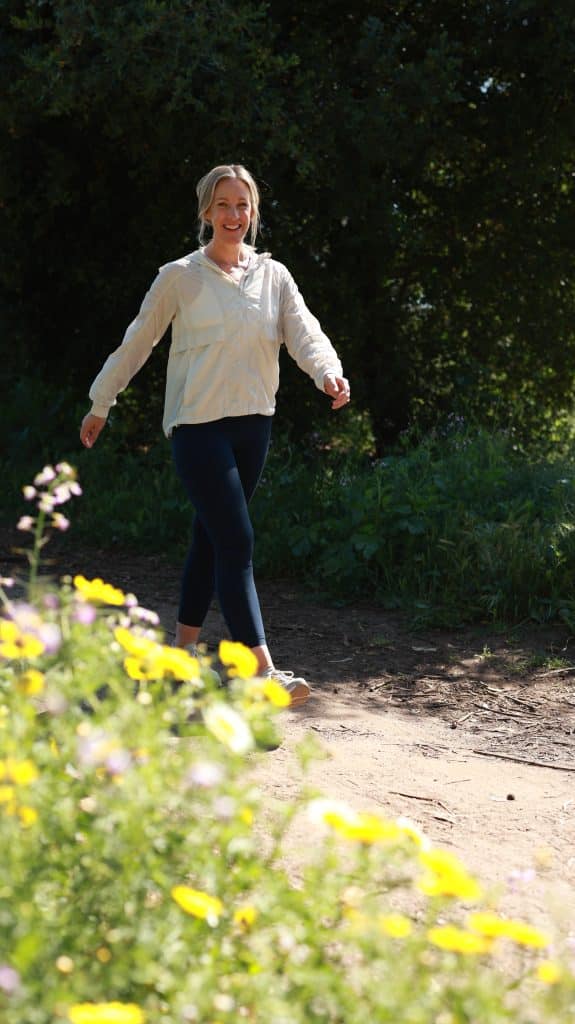
Is a Weighted Vest Right for You?
Here’s what to consider:
- What do you want your walks to feel like? Adding a vest can make your walk more challenging and give you a better workout both for your muscles and your cardiovascular health. But if your purpose for walking is to slow down, walk peacefully and not optimize for every little bit of benefit, it may detract from your enjoyment of your daily walk.
- There are many options for weight-bearing forms of exercise. Supporting your bones with weight-bearing movement is one of the most empowering things you can do right now. The BEST way to support this is to do weight bearing exercises such as Pilates, walking, jumping and lifting weights. So first focus on walking, and if you want to consider a weighted vest for a bit more challenge, go for it, but know that it might not be the most significant factor in supporting bone density.
- Are you looking for ways to add resistance without high-intensity exercises? A vest can allow you to add a bit more resistance to your body and bones and add challenge without jumping or jarring your joints.
- Your posture, alignment and injuries. Adding weight to your upper spine can aggravate certain conditions. When I first started wearing one I noticed that it aggravated my scoliosis. With time, it subsided but I made sure to pay close attention to any back pain or neck tension to ensure I didn’t cause any issues. If you have postural conditions that aren’t ideal, adding 10 pounds on top of it may not help you feel your best. Pay attention to your body and let your body be your guide.
- Your core strength. If you decide to add a weighted vest to your routine, make sure that you are maintaining and building a strong core! This is essential to support healthy spinal alignment and healthy movement patterns before adding extra weight to your skeletal system. As you know, Pilates is perfect for this! (Try this at-home Pilates program for great results)
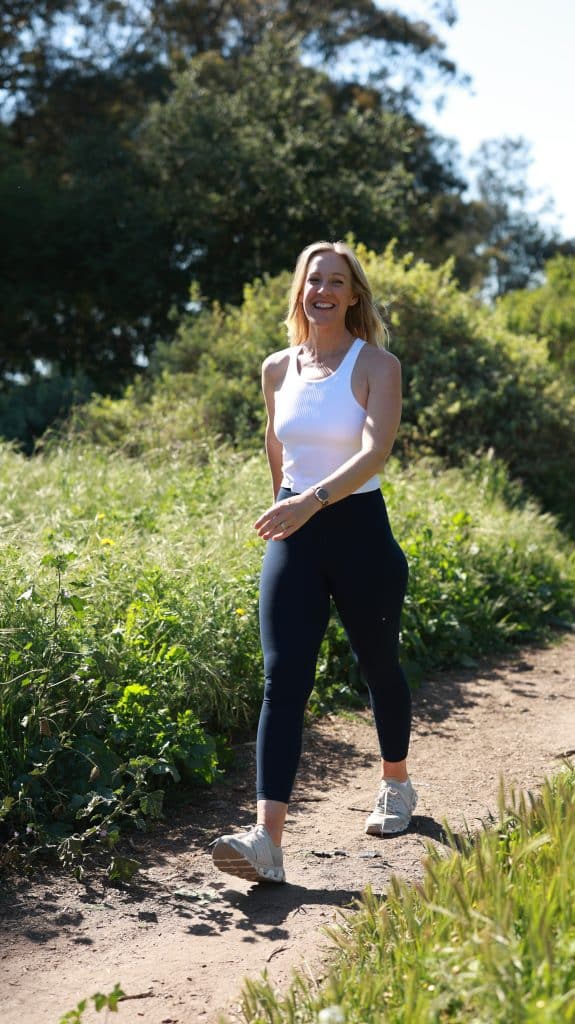
How to get started…
If you’re interested in adding a weighted vest to your routine here are a few things to consider:
- Start light and work your way up. Consider 10% or less of your body weight and listen to your body. It should feel like a gentle nudge and awareness of extra weight, but not a burden that is hard or uncomfortable to wear.
- Start with short walks. Start with 5-10 minutes to see how you feel and gradually work your way up from there. I’ve found that 30 minutes is my max for feeling good while wearing it.
- Consider time of day. It does not feel good in my body to wear my vest on 6am walks. My body is still waking up and it feels unnecessary and uncomfortable. However, when I head out for a 10 minute walk in the afternoon, it feels better. Again, listen to your body and let your body be your guide.
If you’re curious, here’s the vest I have – mine is 12 lbs.
The jury is out, so make a choice that feels best to you.
Remember, that no matter how much something is trending on social media, there is usually not a “magic bullet” that leads to dramatic results.
The studies show that weighted vests can bring positive results when also paired with exercise. But the research is limited.
We do know that walking alone is one of the BEST things you can do for your health, and adding weight bearing exercises to your routine is also essential, especially if you’re a woman over the age of 35.
So keep moving, keep challenging yourself and continue to pursue movement that you enjoy so that you want to keep doing it for years to come.


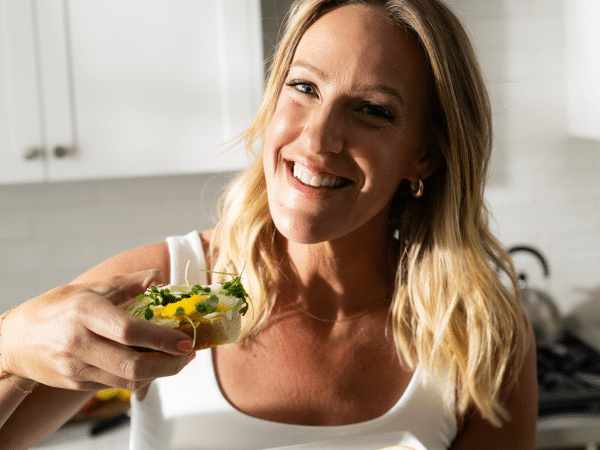
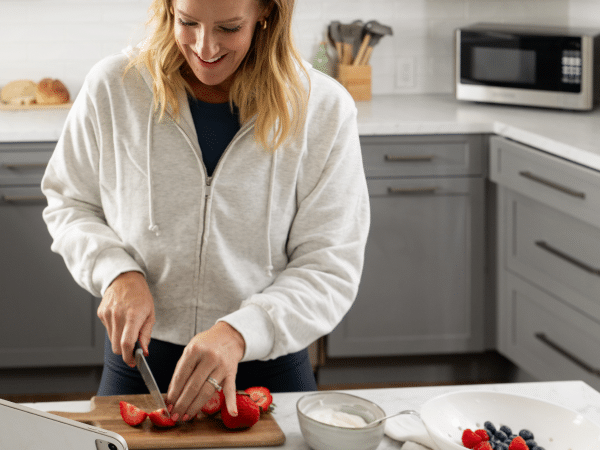



24 thoughts on “Can a Weighted Vest Really Help with Bone Health and Strength? Here’s What You Need to Know”
I find that my posture seems better ealkingvwithbmyb10 lbs weighted vest. I walk about 20-30 minutes my shoulder blades seem ti be in the right places!
We’re so glad that you’re experiencing the positive effects of walking with a weighted vest and that you’re listening to your body and doing what feels best for you! We are cheering you on, Marilyn!
I had back surgery and shoulder surgery and my walk seemed more comfortable with 5 pounds in the front and 5 pounds in the back and I 84 years old so I will continue with this weighted jacket
We’re so sorry that you needed surgery but so glad that you are listening to your body and found what works best for you! We’re celebrating the way that you are caring for yourself, Anne! Way to go!
I admit I was intrigued by the hype. I walk my inherited dog 6-7 days a week and I add the vest 2-3x a week. I definitely have a love/hate relationship with it! I love the idea of burning more calories and I have noticed a slight difference in my cardiovascular health since I started wearing it(at first I huffed and puffed around the block I had no problem walking without it, but now I can wear it no problem). I don’t know that it has improved my anxiety at all as some people claimed. Walking and my 5Ks have improved my mental health more than anything. I do think it’s been a source of strength training for me because I can now climb the stairs in my house without my knees killing me. I don’t think it’s magic, but I figure it can’t hurt to add it in a few times a week.
We love hearing the difference that walking has made for you and glad that the vest has added to your progress. We are celebrating the way that you’re listening to your body and doing what feels best for you!
Shat company do you suggest to purchase
I am in canada
Great question, Catherine! While we do not have any specific recommendations for vests, I’m happy to share the vest that Robin has here.
Where can I purchase the weighted vest?
Hi Beth! If you are curious about the vest that Robin owns, you can find it here!
You referenced an at-home Pilates program but I did not see a link to it.
Can you send the link? Thanks!
We’d love to invite you to give Lindywell a try with a FREE, 14-day trial. Simply click here for more info!
Unsubscribe
Thanks for letting us know you’d rather not hear from us anymore, Donna! We’re glad you’ve given Lindywell a try!
I would like to know the price of your weighted vest please.
Hi Carole! While we do not have weighted vests for purchase, nor do we have any recommendations, we are happy to share that Robin owns this vest in 12 pounds.
More information please
Hi Sheila! Robin included lots of links in her post to help you make an informed decision on whether wearing a weighted vest is right for you. Simply click on the highlighted words and phrases in the post. We encourage you to listen to your body and do what’s best for you!
Please take me off your list. Thank you.
Thanks so much for your comment and letting us know you’d prefer to no longer hear from us. We’ve gone ahead and unsubscribed you from emails and text messages. Don’t hesitate to reach out to the Care Team at [email protected] if we can help with anything else!
I appreciated the thoughtful research that went into this article. Great attention to Science. I appreciate that Robin.
We’re so glad that you’ve found this helpful and we are cheering you on, Kira!
I too have scoliosis and have had surgery with rods and screws and a fair amount of fusion. It surprised me to read that you also have scoliosis and used a weighted vest. Im curious if you had your curvature measured before and after…all I can think of is “ouch”! Gravity alone does a good enough job of weighing down the spine.
It sounds like you’ve been through quite a journey with scoliosis and your surgery, I can imagine why the idea of adding extra weight might feel concerning, Brenda. We’re so glad you’re listening to your body and doing what’s best for you. Robin knows everyone’s situation is unique, and especially with scoliosis or spinal fusion, it’s so important to consult with your medical professionals before trying something like a weighted vest (she did not provide any personal clinical testing details). As she said regarding the results “the jury is out, so make a choice that feels best to you”.